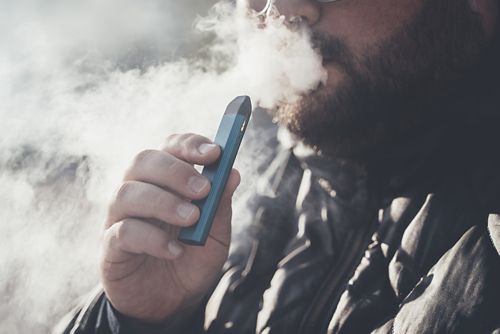Vaping is a bad idea. It just is. If you’re a cancer patient or survivor, it’s a really bad idea.
Here’s why.
Vaping is a bad idea. It just is. If you’re a cancer patient or survivor, it’s a really bad idea.
Here’s why.

Vaping is a bad idea. It just is. If you’re a cancer patient or survivor, it’s a really bad idea.
Vaping involves using a battery-operated device to inhale a vapor. That’s where the word “vaping” comes from. Devices may look like traditional cigarettes, cigars, or pipes, or everyday items such as pens or flash drives.
JUUL® refers to a popular brand of vaping device.
Vaping can affect how your brain develops. It can harm your lungs. In some cases, vaping has caused lung damage and scarring that may be permanent. Scientists are still learning about the long-term effects of vaping.
We know that cancer and cancer treatment can have short-term and long-term effects on the body.
If you vape when you are a cancer patient or survivor, you could be creating a “double whammy” kind of situation. Your body may be a higher risk for health problems because of your cancer treatment. Vaping is an extra insult.
A recent study highlights the value of leading a healthy lifestyle for cancer survivors.
Myth: The substance inhaled during vaping is only water vapor.
Truth: The vapor can contain known harmful and potentially harmful substances, including:
Myth: Vaping is safer than tobacco cigarettes.
Truth: It is difficult for consumers to know what e-cigarette products contain, according to the Centers for Disease Control and Prevention (CDC), the nation’s health protection agency and part of the U.S. Department of Health and Human Services. For example, some e-cigarettes marketed as containing zero percent nicotine have been found to contain nicotine. A recent CDC study found that 99% of the e-cigarettes sold in the United States (at locations included in the study) contained nicotine.
Nicotine can harm the developing brain, which continues to mature until you are about 25.
Each time a new memory is created or a new skill is learned, stronger connections – or synapses – are built between brain cells. Young people’s brains build synapses faster than adult brains. Nicotine changes the way these synapses are formed.
Nicotine can damage the parts of the brain that control attention, learning, mood, and impulse control.
Using nicotine when you are young may also increase risk for future addiction to other drugs.
For help to stop vaping, it’s a good idea to talk to a member of your care team, a school counselor, or a health provider in your community. Consider the reasons why you vape.
Think about steps you can take to meet those needs in a healthy way.
Healthy ways to relax may include:
Sometimes you may want to vape because other people are doing it. Sometimes you may not think it through before you decide to join in.
Reflect on how you may respond ahead of time. Maybe say “Not today” or “I’m not interested.”
Consider other fun activities you can do with your friends.
Consider visiting these sites:
—
Together does not endorse any branded product mentioned in this article.
—
Reviewed: August 2020
Care for your body, mind, and soul. Find out more about how to live a healthy life.
Not smoking is one of the simplest ways to prevent cancer, heart disease, and lung disease. Get tips to stop smoking.
Take control of your health! These 8 steps will empower you, help you feel better, and protect your body from disease.